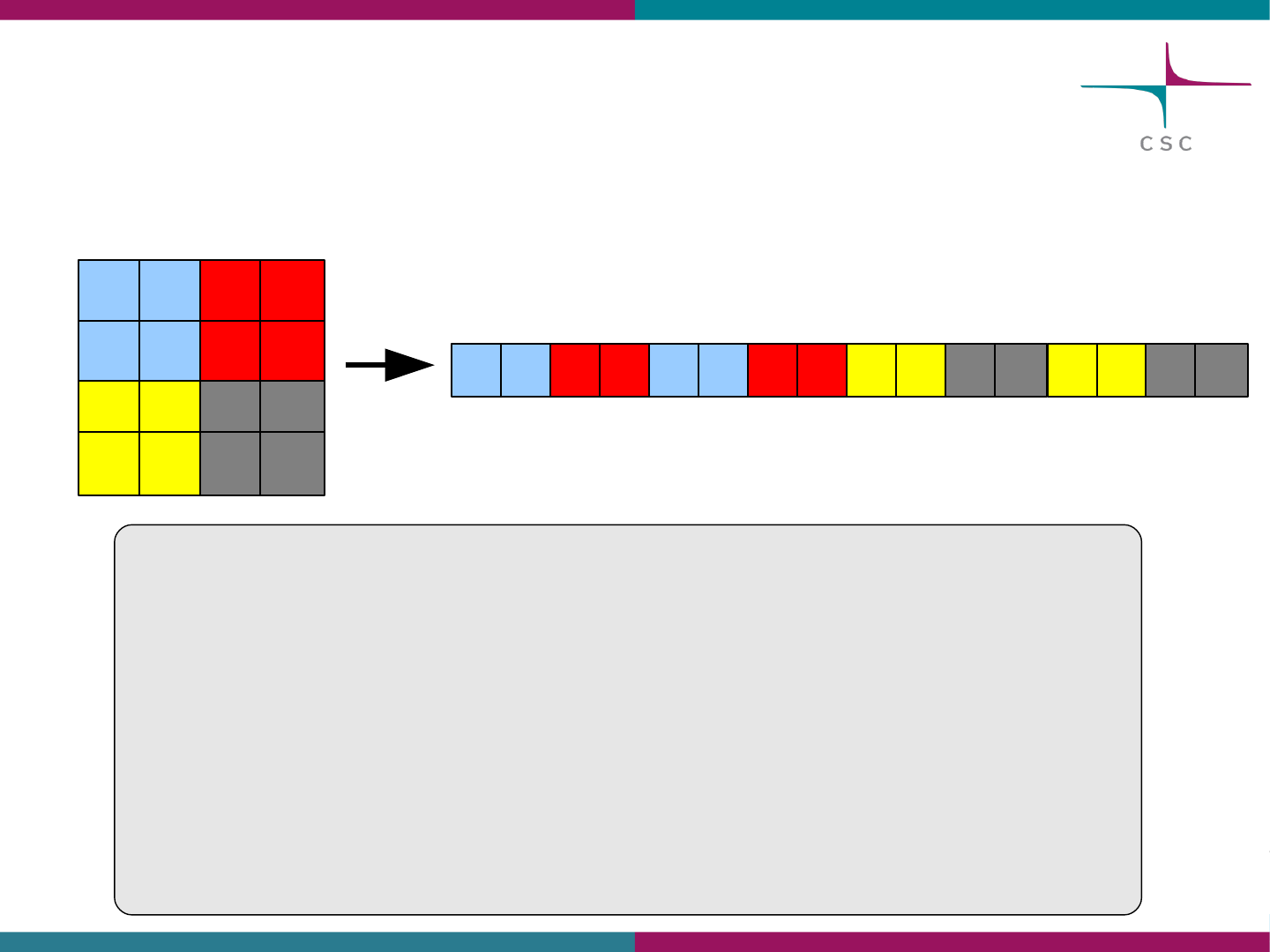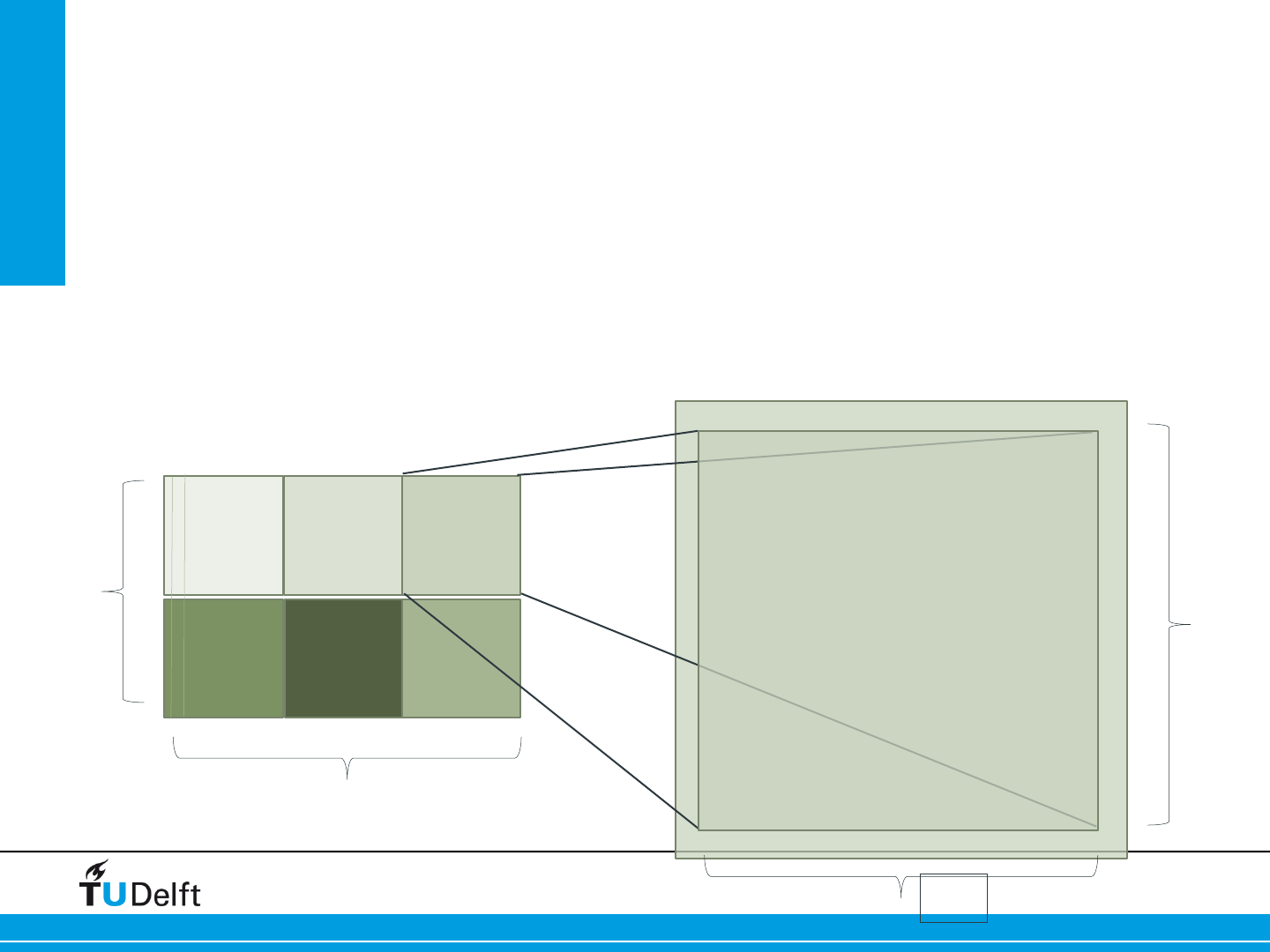
Type to enter text
Challenge the future
Delft
University of
Technology
Parallel programming
MPI IO
Jan Thorbecke

2
• This course is partly based on the MPI courses developed by
–
Rolf Rabenseifner at the High-Performance Computing-Center
Stuttgart (HLRS), University of Stuttgart in collaboration with the
EPCC Training and Education Centre, Edinburgh Parallel Computing
Centre, University of Edinburgh.
http://www.hlrs.de/home/
https://www.epcc.ed.ac.uk
• CSC – IT Center for Science Ltd.
–
https://www.csc.fi
–
https://research.csc.fi
• http://mpitutorial.com
Acknowledgments
2

3
Contents
• Parallel IO
•
POSIX-IO
•
single MPI-task does all
•
each MPI-tasks one file
•
MPI-IO
•
Independent
•
exercise: exa1 MPI_File_write_at
•
exercise: exa2 MPI_File_set_view
•
collective
•
exercise: mpiio_2D MPI_File_write_all
• Examples

Parallel IO
4
Parallel I/O
...1101101010101101110110010101010101001010101...
•
I/O (Input/output) is needed in all programs but is often overlooked
• Mapping problem: how to convert internal structures and domains to
files which are a streams of bytes
• Transport problem: how to get the data efficiently from hundreds to
thousands of nodes on the supercomputer to physical disks

Parallel IO
5
Parallel I/O
•
Good I/O is non-trivial
–
Performance, scalability, reliability
–
Ease of use of output (number of files, format)
• Portability
•
One cannot achieve all of the above - one needs to decide what is most
important
•
New challenges
–
Number of tasks is rising rapidly
–
The size of the data is also rapidly increasing
• The need for I/O tuning is algorithm & problem specific
•
Without parallelization, I/O will become scalability bottleneck for
practically every application!

IO layers
6
I/O layers
MPI-IO
Parallel file system
POSIX
syscalls
High level I/O
Libraries
Applications
• High-level
–
application: need to write or read data from
disk
• Intermediate
–
libraries or system tools for I/O
–
high-level libraries
•
HDF5, netcdf
–
MPI-I/O
–
POSIX system calls (fwrite / WRITE)
• Low-level:
–
parallel filesystem enables the actual
parallel I/O
–
Lustre, GPFS, PVFS, dCache

POSIX IO
7
POSIX I/O
• Built in language constructs for performing I/O
–
WRITE/READ/OPEN/CLOSE in Fortran
–
stdio.h routines in C (fopen, fread, fwrite, ...)
•
No parallel ability built in - all parallel I/O schemes have to be
programmed manually
• Binary output not necessarily portable
• C and Fortran binary output not necessarily compatible
• Non-contiguous access difficult to implement efficiently
•
Contiguous access can be very fast

File System Fundamentals
Single Logical File
e.g. /work/example
File automatically
divided into stripes
Stripes are written/read from
across multiple drives
To achieve fast bandwidth
reading or writing to disk....
8

Text
File decomposition – 2 Megabyte Stripes
9
3-0
5-0
7-0
11-0
3-1
5-1
7-1
11-1
11-0
7-0
3-0
5-0
2MB
2MB
2MB
2MB
2MB
2MB
2MB
2MB
3-1
OST 3
Lustre
Client
7-1
OST 5
OST 7
OST 11
5-1
11-1

Disk
Spokesperson, basically serial I/O
• One process performs I/O.
•
Data Aggregation or Duplication
•
Limited by single I/O process.
• Easy to program
• Pattern does not scale.
•
Time increases linearly with amount of data.
•
Time increases with number of processes.
• Care has to be taken when doing the “all to one”-
kind of communication at scale
• Can be used for a dedicated IO Server
(not easy to program) for small amount of data
10

One file per process
• All processes perform I/O to
individual files.
•
Limited by file system.
• Easy to program
• Pattern does not scale at large
process counts.
•
Number of files creates
bottleneck with metadata
operations.
•
Number of simultaneous
disk accesses creates
contention for file system
resources.
11

filesystem
Shared File
• Each process performs I/O to a
single file which is shared.
• Performance
•
Data layout within the shared
file is very important.
•
At large process counts
contention can build for file
system resources (OST).
• Programming language might not
support it
•
C/C++ can work with fseek
•
No real Fortran standard
12

A little bit of all, using a subset of
processes
•
Aggregation to a processor group which processes the data.
•
Serializes I/O in group.
•
I/O process may access independent files.
•
Limits the number of files accessed.
•
Group of processes perform parallel I/O to a shared file.
•
Increases the number of shares to increase file system
usage.
•
Decreases number of processes which access a shared file
to decrease file system contention.
13

UM per Timestep I/O
●
!"#$%&'$()#*$( #+,-% ','./'(#$#('0+.$1%'#.2,1'#$4).5*&3.324#678#4'& 9'&4#
●
:$5*#*$.(%+.;#$#5'&/$+.#.2,1'#0+%'4#<=3&/&$.#678#2.+/4>
14
●
?*'.#(321%+.;#/*'#.2,1'#53&'4@#+('$%%)#53,-2/'#/+,'#ABC#$,32./#30#678#
-'5&'#+4#&'(25'(#/3#*$%0
●
678#/+,'#4*32%(#45$%'#D#12/#+/#(3'4.E/#D#*3F#53,'G
●
H*'#4+.;%'#678#4'&9'&#-'�+%'#1'53,'4#39'&F*'%,'(
●
6.5&'$4+.;#.2,1'#4,$%%'&#-$5I'/4
●
678#4'&9'5%%'5/4#($/$#+.#$#-&'45&+1'(#3&('&@#53,-2/'#/$4I4#F$+/# 035,-%'/+3.

I/O Performance : To keep in mind
• There is no “One Size Fits All” solution to the I/O problem.
• Many I/O patterns work well for some range of parameters.
• Bottlenecks in performance can occur in many locations.
(Application and/or File system)
• Going to extremes with an I/O pattern will typically lead to
problems.
•
I/O is a shared resource. Expect timing variation
15

BeeGFS
• Installed on DelftBlue
•
beegfs-ctl —getentryinfo .
•
beegfs-ctl --liststoragepools
16

MPI-IO
17

MPI-IO
18
MPI I/O
•
MPI I/O was introduced in MPI-2
• Defines parallel operations for reading and writing files
–
I/O to only one file and/or to many files
–
Contiguous and non-contiguous I/O
–
Individual and collective I/O
–
Asynchronous I/O
• Portable programming interface
• Potentially good performance
•
Easy to use (compared with implementing the same algorithms on your
own)
• Used as the backbone of many parallel I/O libraries such as parallel
NetCDF and parallel HDF5
• By default, binary files are not necessarily portable

Basic concepts MPI-IO
19
Basic concepts in MPI I/O
• File handle
–
data structure which is used for accessing the file
• File pointer
–
position in the file where to read or write
–
can be individual for all processes or shared between the processes
–
accessed through file handle
• File view
–
part of a file which is visible to process
–
enables efficient non-contiguous access to file
• Collective and independent I/O
–
collective: MPI coordinates the reads and writes of processes
–
independent: no coordination by MPI

Logical view
20
Höchstleistungsrechenzentrum Stuttgart
Rolf RabenseifnerMPI Course
[3] Slide 283 / 338
Logical view / Physical view
mpi processes of a communicator
file, physical view
file, logical view
addressed
only by hints
scope of
MPI-I/O
Message Passing Interface (MPI) [03]
Chap.14 Parallel File I/O – Block 1

21
Höchstleistungsrechenzentrum Stuttgart
Rolf RabenseifnerMPI Course
[3] Slide 284 / 338
Definitions
etype (elementary datatype)
filetype process 2
file displacement (number of header bytes)
filetype process 0
filetype process 1
file
holes
tiling a file with filetypes:
0 5
1 6
2 3 4 7 8 9
view of process 2
view of process 0
view of process 1
0 1 2 3 4 5 6 7 8 9
I/O – Definitions
Chap.14 Parallel File I/O – Block 1
Short tour – 6 slides – 2 remaining
Definitions

Comments
22
Höchstleistungsrechenzentrum Stuttgart
Rolf RabenseifnerMPI Course
[3] Slide 285 / 338
Comments on Definitions
file -an ordered collection of typed data items
etypes -is the unit of data access and positioning / offsets
-can be any basic or derived datatype
(with non-negative, monotonically non-decreasing, non-absolute displacem.)
-generally contiguous, but need not be
-typically same at all processes
filetypes -the basis for partitioning a file among processes
-defines a template for accessing the file
-different at each process
-the etype or derived from etype(displacements:
non-negative, monoton. non-decreasing, non-abs., multiples of etype extent)
view -each process has its own view, defined by:
a displacement, an etype, and a filetype.
-The filetype is repeated, starting at displacement
offset -position relative to current view, in units of etype
Chap.14 Parallel File I/O – Block 1

23
Höchstleistungsrechenzentrum Stuttgart
Rolf RabenseifnerMPI Course
[3] Slide 287 / 338
Default View
•Default:
– displacement = 0 each process
– etype = MPI_BYTE has access to
–filetype = MPI_BYTE the whole file
• Sequence of MPI_BYTE matches with any datatype (see MPI-3.0, Section 13.6.5)
• Binary I/O (no ASCII text I/O)
MPI_FILE_OPEN(comm, filename, amode, info, fh)
file
0 1 2 3 4 5 6 7 8 9
view of process 0
0 1 2 3 4 5 6 7 8 9
view of process 1
0 1 2 3 4 5 6 7 8 9
view of process 2
0 1 2 3 4 5 6 7 8 9
Chap.14 Parallel File I/O – Block 1

A simple MPI-IO program in C
'
MPI_File fh;!
MPI_Status status;
!
MPI_Comm_rank(MPI_COMM_WORLD, &rank);!
MPI_Comm_size(MPI_COMM_WORLD, &nprocs);!
bufsize = FILESIZE/nprocs;!
nints = bufsize/sizeof(int);
!
MPI_File_open(MPI_COMM_WORLD, ‘FILE’,!
MPI_MODE_RDONLY, MPI_INFO_NULL, &fh);!
MPI_File_seek(fh, rank * bufsize, MPI_SEEK_SET);!
MPI_File_read(fh, buf, nints, MPI_INT, &status);!
MPI_File_close(&fh);
24
bufsize
bufsize
bufsize
bufsize
0 1 2 3

Write instead of Read
•
Use MPI_File_write'or'MPI_File_write_at'
•
Use MPI_MODE_WRONLY'or'MPI_MODE_RDWR'as the flags to
MPI_File_open'
•
If the file doesn’t exist previously, the flag MPI_MODE_CREATE'
must'be passed to MPI_File_open'
• We can pass multiple flags by using bitwise-or ‘|’ in C, or addition
‘+’ or IOR in Fortran
• If not writing to a file, using MPI_MODE_RDONLY might have a
performance benefit. Try it.
25

Parallel write
26
!"#$"%&'#()*()+
+,-.'&!/+
+/&!0/1/2'3#3.+
+/32.$."'44'5667'87'9:8;7'<8=57'8>)?8@5+
+/32.$."'44'?)A)(?B&!/C-2%2,-C-/D.E+
+/32.$."7'!%"%&.2."'44'FG(>)HIJJ+
+/32.$."7'K/&.3-/#3BFG(>)E'44'L(<+
+/32.$."BM/3KH&!/C#NN-.2CM/3KE'44';8?*+
+1%00'&!/C/3/2B566E
+1%00'&!/C1#&&C"%3MB&!/C1#&&CO#"0K7'9:8;7P'+
+++566E+
+K#'8'H'I7'FG(>)+
++L(<B8E'H'9:8;'Q'FG(>)'R'8+
+.3K'K#+
SSS
SSS
+1%00'&!/CN/0.C#!.3B&!/C1#&&CO#"0K7'T)5?)T7'P+
++++++&!/C&#K.CO"#30U'R'&!/C&#K.C1".%2.7'P+
++++++&!/C/3N#C3,007'<8=57'566E+
+1%00'&!/C2U!.C-/D.B&!/C/32.$."7'8>)?8@57566E+
+;8?*'H'9:8;'Q'FG(>)'Q'8>)?8@5+
+1%00'1%00+&!/CN/0.C-..MB<8=57;8?*7P
++++++&!/C-..MC-.27+566E+
+1%00'&!/CN/0.CO"/2.B<8=57'L(<7'FG(>)7'P+
++++++&!/C/32.$."7'?)A)(?7'566E+
+1%00'&!/CN/0.C10#-.B<8=57'566E+
+1%00'&!/CN/3%0/D.B566E+
.3K'!"#$"%&'#()*()+
• Multiple processes write to a
binary file test.
• First process writes integers 1-
100 to the beginning of the file,
etc.
Example: parallel write
Note !
File (and total data) size depends
on number of processes in this
example

27
Höchstleistungsrechenzentrum Stuttgart
Rolf RabenseifnerMPI Course
[3] Slide 291 / 338
Writing with Explicit Offsets
• writes count elements of datatype from memory buf to the file
• starting offset * units of etype
from begin of view
• the elements are stored into the locations of the current view
• the sequence of basic datatypes of datatype
(= signature of datatype)
must match
contiguous copies of the etype of the current view
MPI_FILE_WRITE_AT(fh,offset,buf,count,datatype,status)
I/O – WRITE / Explicit Offsets
Message Passing Interface (MPI) [03]
Chap.14 Parallel File I/O – Block 1
MPI_File_Seek and MPI_File_Write combined in one call

Exercise: MPI-IO exa1:
Four processes write a file in parallel
28
Höchstleistungsrechenzentrum Stuttgart
Rolf RabenseifnerMPI Course
[3] Slide 292 / 338
MPI–IO Exercise 1: Four processes write a file in parallel
• each process should write its rank (as one character) ten times
to the offsets = my_rank + i * size_of_MPI_COMM_WORLD, i=0..9
• Result: “0123012301230123012301230123012301230123“
• Each process uses the default view
writing
1 1 1 1 1 1 ...
writing
2 2 2 2 2 2 ...
writing
3 3 3 3 3 3 ...
writing
0 0 0 0 0 0 ...
mpi processes of
a communicator
file
• please, use skeleton:
cp ~/MPI/course/C/mpi_io/mpi_io_exa1_skel.c my_exa1.c
cp ~/MPI/course/F/mpi_io/mpi_io_exa1_skel.f my_exa1.f
see also login-slides
I/O – Exercise 1
Chap.14 Parallel File I/O – Block 1
Sol.
cd MPI_IO
cp mpi_io_exa1_skel.c my_exa1.x

29
mpi_io_exa1.c
OST 1
J
K
L
L
J
K
OST 0
OST 2
J
K
L
J
K
L
file'on'disk(s)
J
K
L
J
K
L
J
K
L
temp'buffer'
user'buffer'
P2P1P0
write
communication

File Views
• Provides a set of data visible and accessible from an
open file
• A separate view of the file is seen by each process
through triple := (displacement, etype, filetype)
• User can change a view during the execution of the
program - but collective operation
• A linear byte stream, represented by the triple (0,
MPI_BYTE, MPI_BYTE), is the default view.
30

31
Höchstleistungsrechenzentrum Stuttgart
Rolf RabenseifnerMPI Course
[3] Slide 295 / 338
Set/Get File View
• Set view
– changes the process’s view of the data
– local and shared file pointers are reset to zero
– collective operation
– etype and filetype must be committed
– datarep argument is a string that specifies the format
in which data is written to a file:
“native”, “internal”, “external32”, or user-defined
– same etype extent and same datarep on all processes
• Get view
– returns the process’s view of the data
MPI_FILE_SET_VIEW(fh, disp, etype, filetype, datarep, info)
MPI_FILE_GET_VIEW(fh, disp, etype, filetype, datarep)
Chap.14 Parallel File I/O – Block 2
MPI_File_set(get)_view

MPI_File_set_view
32
File view
MPI_File_set_view(fhandle,4disp,4etype,4filetype, datarep, info)
disp Offset from beginning of file. Always in bytes
etype Basic MPI type or user defined type
Basic unit of data access
Offsets in I/O commands in units of etype
filetype Same type as etype or user defined type constructed of etype
Specifies which part of the file is visible
datarep Data representation, sometimes useful for portability
“native”: store in same format as in memory
info Hints for implementation that can improve performance
MPI_INFO_NULL: No hints

File View
33
File view
• A file view defines which portion of a file is “visible” to a process
• File view defines also the type of the data in the file (byte, integer,
float, ...)
•
By default, file is treated as consisting of bytes, and process can access
(read or write) any byte in the file
• A file view consists of three components
–
displacement : number of bytes to skip from the beginning of file
–
etype : type of data accessed, defines unit for offsets
–
filetype : portion of file visible to process
•
same as etype or MPI derived type consisting of etypes
Default file view
Default file view
etype=MPI_INT
filetype=MPI_INT
etype=MPI_INT
filetype=MPI_INT
etype=MPI_INT
filetype=MPI_Type_vector(4, 1, 2, MPI_INT, &filetype);
etype=MPI_INT
filetype=MPI_Type_vector(4, 1, 2, MPI_INT, &filetype);
1 2 3 4 5 6 7 8
1 3 5 7

MPI_File_set_view (picture 1)
34
P2
P1
P0
read
file'on'disk(s)
(+4-
'/)-'
0+%'/)-'

MPI_File_set_view (picture 2)
35
P2
P1
P0
read
file'on'disk(s)
(+4-
'/)-'
0+%'/)-'

36
File view for non-contiguous
data
MPI_TYPE_VECTOR(4, 1, 4, MPI_INTEGER, filetype)
2D-array distributed column-wise
File
...
INTEGER :: count = 4
INTEGER, DIMENSION(count) :: buf
...
CALL MPI_TYPE_VECTOR(4, 1, 4, MPI_INTEGER, filetype, err)
CALL MPI_TYPE_COMMIT(filetype, err)
dispJ=JmyidJ*Jintsize
CALLJCALL MPI_FILE_SET_VIEW(file, disp, MPI_INTEGER, filetype, “native”, &
MPI_INFO_NULL, err)
CALLJMPI_FILE_WRITE(file, buf,Jcount, MPI_INTEGER,Jstatus,Jerr)
...

37
Storing multidimensional arrays
in files
Domain decomposition for 2D-
array
File
MPI_TYPE_CREATE_SUBARRAY(...)
!!!
"#$%&'&("))"*+,-*"."/012"103
"#$%&'&("))"*45*+,-*"."/062"603
"#$%&'&(2"7#8&$9#:$/6263"))"54;
"!!!
"8<#=>?(%=>::(79/8<#=>:88=@:(A72"BC+D2"62"*EFGE*2"-GG3"
">?AA"8<#=%H<&=>(&?%&=9IJ?((?H/62"*+,-*2"*45*+,-*2"*EFGE*2"
""""""8<#=#$%&'&(2"8<#=:(7&(=>2";+K-ECL-2"-GG3
">?AA"8<#=%H<&=>:88#%/;+K-ECL-3"
">?AAM>?AA"8<#=N#A&=9&%=O#&@/;+K-2"P2"8<#=#$%&'&(2";+K-ECL-2"QRFE+S-T2"U
""""""8<#=#$N:=$IAA2"-GG3"
">?AAM8<#=N#A&=@(#%&/;+K-2"54;2MVW4RE2"8<#=#$%&'&(2M*EFE4*2M-GG3
!!!"

Exercise: MPI-IO exa2:
Using fileviews and individual filepointers
38
Höchstleistungsrechenzentrum Stuttgart
Rolf RabenseifnerMPI Course
[3] Slide 311 / 338
MPI–IO Exercise 2: Using fileviews and
individual filepointers
• Copy to your local directory:
cp ~/MPI/course/C/mpi_io/mpi_io_exa2_skel.c my_exa2.c
cp ~/MPI/course/F/mpi_io/mpi_io_exa2_skel.f my_exa2.f
• Tasks:
– Each MPI-process of my_exa2 should write one character to a
file:
• process “rank=0” should write an ‘a’
• process “rank=1” should write an ‘b’
• ...
– Use a 1-dimensional fileview with MPI_TYPE_CREATE_SUBARRAY
– The pattern should be repeated 3 times, i.e., four processes
should write: “abcdabcdabcd”
– Please, substitute “____” in your my_exa2.c / .f
–Compile and run your my_exa2.c / .f
I/O – Exercise 2
Chap.14 Parallel File I/O – Block 2

Exercise: MPI-IO exa2:
Using fileviews and individual filepointers
39
Höchstleistungsrechenzentrum Stuttgart
Rolf RabenseifnerMPI Course
[3] Slide 312 / 338
MPI–IO Exercise 2: Using fileviews and
individual filepointers, continued
etype = MPI_CHARACTER / MPI_CHAR
filetype process 2
file displacement = 0 (number of header bytes)
filetype process 0
filetype process 1
file
tiling a file with filetypes:
view of process 2
view of process 0
view of process 1
filetype process 3
holes
a b c
d
a b c
d
a b c
d
b b b
a a a
d d d
c c c
view of process 3
see also login-slides
Chap.14 Parallel File I/O – Block 2
Sol.

MPI IO
• The MPI interface support two types of IO:
• Independent
•
each process handling its own I/O independently
•
supports derived data types (unlike POSIX IO)
• Collective
•
I/O calls must be made by all processes participating in a particular I/O
sequence
•
Used the "shared file, all write" strategy are optimized dynamically by
the MPI library.
40

Collective IO with MPI-IO
•
MPI_File_read_all, MPI_File_read_at_all, …
•
_all'+.(+5$/'4#/*$/#$%%#-&35'44'4#+.#/*'#;&32-#4-'5+M'(#1)#/*'#
53,,2.+5$/3&#-$44'(#/3#"N6O=+%'O3-'.#F+%%#5$%%#/*+4#02.5P3.#
• Each process specifies only its own access information – the
argument list is the same as for the non-collective functions
• MPI-IO library is given a lot of information in this case:
•
Collection of processes reading or writing data
•
Structured description of the regions
• The library has some options for how to use this data
•
Noncontiguous data access optimizations
•
Collective I/O optimizations
41

Collective read: two-phase IO
42
OST 1
OST 0
OST 2
file'on'disk(s)
temp'buffer'
user'buffer'
P2P1P0
read
communication

Two techniques : Data sieving and
Aggregation
• Data sieving is used to combine lots of small accesses into a
single larger one
•
Reducing number of operations important (latency)
•
A system buffer/cache is one example
• Aggregation refers to the concept of moving data through
intermediate nodes
•
Different numbers of nodes performing I/O (transparent to the user)
• Both techniques are used by MPI-IO and triggered with HINTS.
43

Data Sieving read
44
24'&Q4#&'R2'4/#03&#.3.S53./+;2324#($/$#<########>#0&3,#$#0+ %'#
&'$(#$#53./+;2324#5*2.I#+./3#,',3&)#
53-)#&'R2'4/'(#-3&/+3.#+.#24'Ұ'&#
'disk(s)
temp'buffer'
user'buffer'

Data Sieving write
45
24'&Q4#.3.S53./+;2324#F&+/'#/3#($/$#<########>#+.#$#0+%'#
&'$(#$#53./+;2324#5*2.I#+./3#,',3&)#
F&+/'#( $/$#/3#/',-#1 200'&#
'disk(s)
temp'buffer'
user'buffer'
F&+/'#53./+;2324#5*2.I#+./3#,',3&)#

Aggregation: only P1 reads
46
OST 1
OST 0
OST 2
file'on'disk(s)
temp'buffer'
user'buffer'
P2P1P0
read
communication

Collective IO
47
Collective operations
•
I/O can be performed collectively by all processes in a communicator
MPI_File_read_all
MPI_File_write_all
MPI_File_read_at_all
MPI_File_write_at_all
• Same parameters as in independent I/O functions
MPI_File_read, MPI_File_write, MPI_File_read_at,
MPI_File_write_at
•
All processes in communicator that opened file must call function
• Performance potentially better than for individual functions
–
Even if each processor reads a non-contiguous segment, in total the read is
contiguous

Collective IO example
48
Collective I/O
• Collective write can be over hundred times faster than the
individual for large arrays!
!!!
"#$%&'&("))"*+,-*"."/012"103
"#$%&'&("))"*45*+,-*"."/062"603
"#$%&'&(2"7#8&$9#:$/6263"))"54;
"!!!
"8<#=>?(%=>::(79/8<#=>:88=@:(A72"BC+D2"62"*EFGE*2"-GG3"
">?AA"8<#=%H<&=>(&?%&=9IJ?((?H/62"*+,-*2"*45*+,-*2"*EFGE*2"
""""""8<#=#$%&'&(2"8<#=:(7&(=>2";+K-ECL-2"-GG3
">?AA"8<#=%H<&=>:88#%/;+K-ECL-3"
">?AAM>?AA"8<#=N#A&=9&%=O#&@/;+K-2"P2"8<#=#$%&'&(2";+K-ECL-2"QRFE+S-T2"U
""""""8<#=#$N:=$IAA2"-GG3"
">?AAM8<#=N#A&=@(#%&=?AA/;+K-2"54;2MVW4RE2"8<#=#$%&'&(2M*EFE4*2M-GG3
!!!"
""

MPIIO hints
49
Giving hints to MPI I/O
• Hints may enable the implementation to optimize performance
• MPI 2 standard defines several hints via MPI_Info object
–
MPI_INFO_NULL : no info
–
Functions MPI_Info_create, MPI_Info_set allow one to create and set hints
• Some implementations allow setting of hints via environment variables
–
e.g. MPICH_MPIIO_HINTS
–
Example: for file “test.dat”, in collective I/O aggregate data to 32 nodes
export MPICH_MPIIO_HINTS=”test.dat:cb_nodes=32”
• Effect of hints on performance is implementation and application
dependent

Exercise: MPI-IO mpiio_2D_r/w.c:
collective operations
50
• Use number of MPI-tasks N, such that sqrt(N) = integer
• review MPI_Cart and MPI_Type_create_subarray
• MPI-IO for writing 2D array (32x32) to disk
• Without running the program draw a picture how the output will
look like.

nx=32;
mpi_dims[0] = mpi_dims[1] = sqrt(nproc);
int ndims = 2;
int dimsf[2] = {nx, nx};
for (i=0; i < 2; i++) {
count[i] = nx / mpi_dims[i];
offset[i] = coords[i] * count[i];
bufsize *= count[i];
}
MPI_Type_create_subarray(ndims, dimsf, count, offset,
MPI_ORDER_C,MPI_INT, &filetype);
51

Picture of mpiio_2D_r output N=16
52
(0,0)
(0,1)
?
?
(1,0)
(1,1)
?
?
?
?
?
?
?
?
?
?
32
32
8
8

N=16 nx=32
• count[i]=nx/dims[i] => count[0]=8; count[1]=8
• offset[i]=coords[i]*count[i] => offset[0]=x*8; count[1]=y*8
• bufsize *= count[i] => 8*8
MPI_Type_create_subarray()
53

54
?
?
?
?
?
?
?
?
?
?
?
?
?
?
?
?
00000000
00000000
……
00000000
11111111
11111111
……
11111111
22222222
22222222
……
22222222
33333333
33333333
……
33333333
44444444
44444444
……
44444444

Example: 3D-Finite Difference
• 3D domain decomposition to distribute the work
•
MPI_Cart_create to set up cartesian domain
• Hide communication of halo-areas with computational work
• MPI-IO for writing snapshots to disk
•
use local and global derived types to exclude halo areas write in
global snapshot file
• Tutorial about domain decomposition:
http://www.nccs.nasa.gov/tutorials/mpi_tutorial2/
55

Problem we want to solve
• We have 2 dim domain on a 2 dimensional processor grid
• Each local subdomain has a halo (ghost cells).
• The data (without halo) is going to be stored in a single file,
which can be re-read by any processor count
• Here an example with 2x3 procesor grid :
56
nx
p
x
ny
p
y
lnx
lny

Approach for writing the file
• First step is to create the MPI 2 dimensional processor grid
• Second step is to describe the local data layout using a MPI
datatype
• Then we create a „global MPI datatype“ describing how the data
should be stored
• Finally we do the I/O
57

Basic MPI setup
!
nx=512; ny=512 ! Global Domain Size!
call MPI_Init(mpierr)!
call MPI_Comm_size(MPI_COMM_WORLD, mysize, mpierr)!
call MPI_Comm_rank(MPI_COMM_WORLD, myrank, mpierr)!
!
dom_size(1)=2; dom_size(2)=mysize/dom_size(1)!
lnx=nx/dom_size(1) ; lny=ny/dom_size(2) ! Local Domain size!
periods=.false. ; reorder=.false.!
call MPI_Cart_create(MPI_COMM_WORLD, dim, dom_size, periods,
reorder, comm_cart, mpierr)!
call MPI_Cart_coords(comm_cart, myrank, dim, my_coords, mpierr)!
!
halo=1!
allocate (domain(0:lnx+halo, 0:lny+halo)) !
58

Creating the local data type
gsize(1)=lnx+2; gsize(2)=lny+2!
lsize(1)=lnx; lsize(2)=lny!
start(1)=1; start(2)=1!
call MPI_Type_create_subarray(dim, gsize, lsize,
start, MPI_ORDER_FORTRAN, MPI_INTEGER,
type_local, mpierr)!
call MPI_Type_commit(type_local, mpierr)
59
lnx
lny
(1,1)
T
!4'#$#421$&&$)#($/$/)-'#/3#
('45&+1'#/*'#.3.53./+;2324#
%$)32/#+.#,',3&)#
T
N$44#/*+4#($/$/)-'#$4#
$&;2,'./#/3#
MPI_File_write_all

And now the global datatype
gsize(1)=nx; gsize=ny!
lsize(1)=lnx; lsize(2)=lny!
start(1)=lnx*my_coords(1); start(2)=lny*my_coords(2)!
call MPI_Type_create_subarray(dim, gsize, lsize,
start, MPI_ORDER_FORTRAN, MPI_INTEGER,
type_domain, mpierr)!
call MPI_Type_commit(type_domain, mpierr)
60
nx
p
x
ny
p
y

Now we have all together
call MPI_Info_create(fileinfo, mpierr)!
call MPI_File_delete('FILE', MPI_INFO_NULL, mpierr)!
call MPI_File_open(MPI_COMM_WORLD, 'FILE',
IOR(MPI_MODE_RDWR,MPI_MODE_CREATE), fileinfo, fh,
mpierr)
!
disp=0 ! Note : INTEGER(kind=MPI_OFFSET_KIND) :: disp !
call MPI_File_set_view(fh, disp, MPI_INTEGER,
type_domain, 'native', fileinfo, mpierr)!
call MPI_File_write_all(fh, domain, 1, type_local,
status, mpierr)!
call MPI_File_close(fh, mpierr)
61

Example
• 1024x1024x512 sized snapshots (2.1 GB) are written to disk; 16
in total (each 100 time steps).
• stripe size is 1MB
• stripe count is 4 or 16
• At 1024 cores each MPI task write a 2 MB portion to disk
• Interlagos 32 core nodes at 2.1 GHz
62

Storage into file per MPI task
63
:$5*#"N6#(3,$+.#*$4#
$#.3.S53./+;2324#
4/3&$;'#9+'F#+./3#/*'#
4.$-4*3/#0+%'U
H*+4#+4#/&$.4-$&'./%)#
*$.(%'(#1)#"N6S68

0
10
20
30
40
50
60
70
80
90
100
32 64 128 256 512 1024 2048 4096
IO-time in seconds
number of cores
3D_FD XE6 (IL 2.1 GHz)
IO with 4 OST
IO with 16 OST
IO-time collective buffering
64
parallel IO build up:
more nodes are used
to stream data to disks
Collective
buffering
communication
overhead for
many small
messages

And there is more
• http://docs.cray.com
•
Search for MPI-IO : „Getting started with MPI I/O“, „Optimizing MPI-
IO for Applications on CRAY XT Systems“
•
Search for lustre (a lot for admins but not only)
•
Message Passing Toolkit
• Man pages (man mpi, man <mpi_routine>, ...)
• mpich2 standard : http://www.mcs.anl.gov/research/projects/
mpich2/
65

Summary
66
Parallel I/O - summary
• POSIX
–
single reader/writer, all read/write, subset read/write
–
user is responsible for communication
•
MPI I/O
–
MPI library is responsible for communication
–
file views enable non-contiguous access patterns
–
collective I/O can enable the actual disk access to remain contiguous
